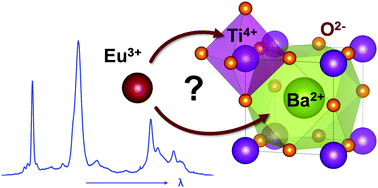Site-selective symmetries of Eu3+-doped BaTiO3 ceramics: a structural elucidation by optical spectroscopy†
Abstract
Eu3+-Doped BaTiO3 ceramics with dopant contents between 0 and 10 mol% were prepared by sol–gel synthesis based on the nominal compositions (Ba1−3xEu2x)TiO3 and Ba(Ti1−xEux)O3−x/2, where two possible substitution mechanisms are addressed. By means of optical spectroscopy, our study gives a plausible elucidation of Eu3+ site occupation in micron-sized BaTiO3 particles. Time-resolved fluorescence line narrowing (TRFLN) shows the presence of five different crystal field sites for europium ions and possible symmetries are inferred for each one. The solubility limit of the lanthanide ion was found to be about 3 mol%. The experimental results are consistent with the preference of Eu3+ to occupy Ba2+ sites regardless of the nominal compositions and target substitution mechanism. However, TRFLN results showed that the dopant could also occupy Ti4+ sites, highlighting the amphoteric character of Eu3+. The existence of anti-Stokes and Stokes vibronic sidebands in the 5D0 → 7F0,1 transitions of Eu3+ ions is confirmed. This can explain the lack of resolution found in room temperature spectra of these transitions due to vibronic mixing of the excited levels. The existence of non-equivalent europium sites with different spectroscopic properties could have an impact on the optical properties of doped-BaTiO3 ceramics and associated applications.



 Please wait while we load your content...
Please wait while we load your content...